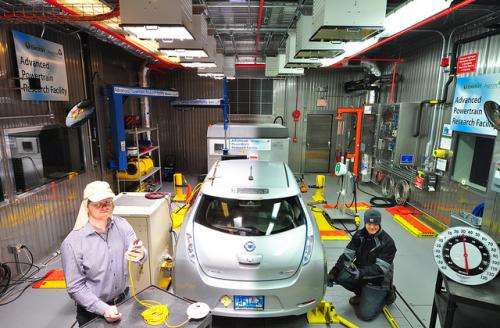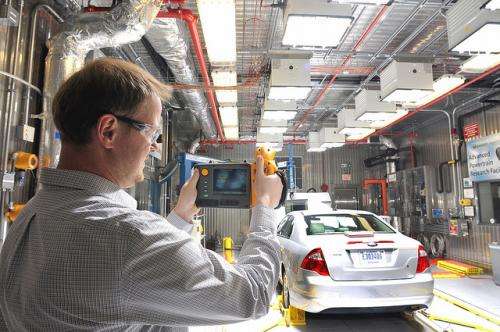Turning up the heat: Argonne's thermal cell facility puts vehicles to the test

(Phys.org)—Imagine having to don shades and a sun hat, then gloves and a heavy winter coat, all in the course of the same day.
That's within the realm of possibility for automotive researchers working in Argonne National Laboratory's world-class Advanced Powertrain Research Facility (APRF), which now includes a thermal chamber that can deliver temperatures ranging from frigid cold to sweltering heat.
The new Environmental Test Cell (ETC) allows engineers to evaluate how extreme hot and cold temperatures affect the fuel economy of next-generation vehicles and to investigate opportunities for improving vehicle system efficiency in these conditions. It is a major upgrade to the APRF, which is the cornerstone of Argonne's internationally recognized research and development program for advanced technology vehicles.
Argonne is the only U.S. Department of Energy national laboratory to have a facility like the ETC. "For Argonne to do this type of research independently is really unique," said Ann Schlenker, interim director of Argonne's Center for Transportation Research. "Vehicle manufacturers often have similar facilities for product development, but the ETC is exceptional in its focus on producing data for the public domain."
"These new controlled thermal test capabilities give researchers a better understanding of how extreme temperatures affect the performance of vehicle powertrains and accessory power draws."

Before the upgrade, scientists at the APRF could test vehicles at temperatures from 72 to 95 degrees Fahrenheit without the ability to assess the effects of solar loading on vehicle performance. With the ETC, engineers can emulate a wide range of temperatures year-round. The facility's refrigeration equipment has achieved temperatures as low as zero degrees, and can uphold 20-degree conditions, even during a summer heat wave. Its heaters can sustain 95-degree testing sessions while it snows outside.
In addition to this extended temperature range, the test cell is equipped with an array of 14 solar lamps that emanate radiant sun energy at 850 watts per square meter—the equivalent of a bright, sunny summer day without clouds. This allows researchers to observe the effects of solar loading on vehicle powertrains and accessories, like air conditioning systems.
"Overlaying the comprehensive research tools and staff expertise in the APRF, these new controlled thermal test capabilities give researchers a better understanding of how extreme temperatures affect the performance of vehicle powertrains," said Schlenker, "as well as accessory power draws such as air conditioner, defroster and cabin heater systems. This knowledge helps researchers propose or develop means to avoid, minimize or offset temperature-related impacts on energy consumption and fuel efficiency."
The APRF houses state-of-the-art technologies for testing and benchmarking advanced technology vehicles, including a four-wheel drive chassis dynamometer, which replicates the forces that moving vehicles experience on the road.
"One can think of a chassis dynamometer as a giant treadmill for vehicles," said Henning Lohse-Busch, a principal mechanical engineer at the APRF. "By keeping vehicles stationary as they are being test-driven, the chassis dynamometer allows us to attach many instruments to the vehicles and to exert tight control over our experiments as we change temperatures in the ETC from below-freezing to near triple-digit. As a result, we can obtain repeatable results between test labs."
The APRF's primary focus is on assessing fuel and energy consumption and measuring the efficiency of the components that make up a vehicle. As vehicles are test-driven—either by a human or the APRF's 'robot driver', which is programmed with an adaptive learning algorithm—researchers can take real-time measurements with a wide set of instruments, ranging from standard fuel meters and emissions analyzers to highly specialized power analyzers for measuring electric energy consumption.
For electric-drive vehicles, scientists can observe how extreme temperatures influence the functioning of battery packs, as well as battery cooling and heating systems. Armed with this information, they can search for ways to improve battery life and energy delivery.
In addition to being able to evaluate hybrid, plug-in and full electric vehicles, engineers can also test a broad range of fuels, including gasoline, diesel, renewable fuels, hydrogen (using both fuel cells and internal combustion) and natural gas.
The ETC also allows Argonne researchers to replicate the U.S. Environmental Protection Agency's new five-cycle fuel economy certification test, which is used to calculate the fuel economy numbers affixed to the windows of new cars. The test assesses fuel economy in different real-world contexts. These include driving aggressively or at high speeds, in urban and highway settings and at temperatures as low as 20 degrees and as high as 95 degrees with the air conditioner operating.
Provided by Argonne National Laboratory


















